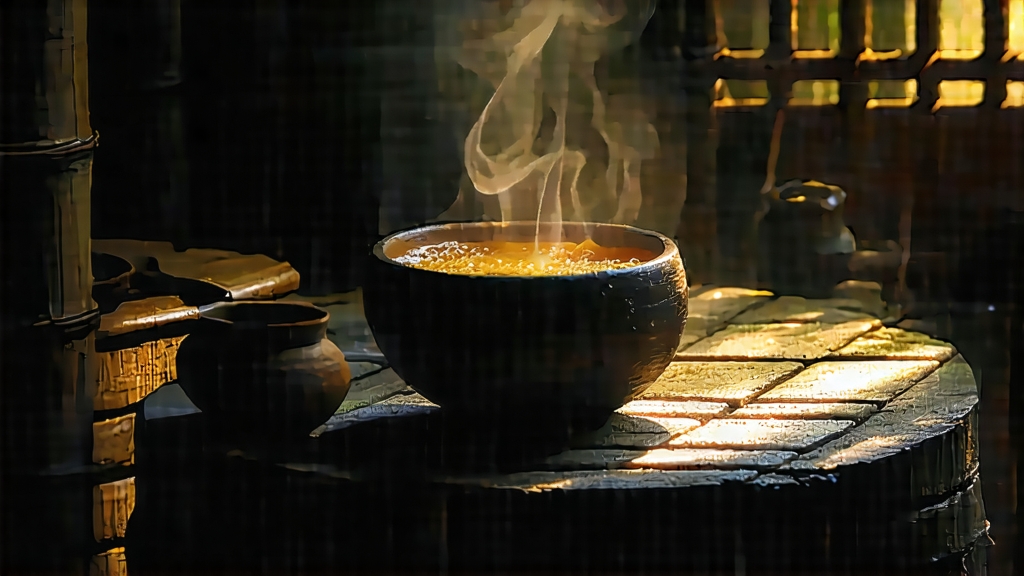
Tucked away in the misty southern mountains of Guangxi Province, Liu Bao tea has spent four centuries quietly fermenting its way into the hearts of merchants, medicine men, and modern connoisseurs. To the uninitiated it is merely another dark brick in the vast family of Chinese heicha (literally “black tea,” yet distinct from the fully-oxidised black teas of the West). To those who know it, Liu Bao is a time capsule: every sip carries the humid breath of the subtropical forest, the creak of bamboo baskets, and the low murmur of the tea horse road that once carried it to the docks of Hong Kong and the kitchens of Kuala Lumpur.
Historical footprints
The earliest written record appears in 1664, when the Qing government listed “Cangwu Liu Bao” as a tribute item from Wuzhou prefecture. Traders soon discovered that the tea not only survived the blistering voyage along the Pearl River but actually improved, its rough edges rounded by the sway of boats and the salt-spray of the delta. By the late 19th century Liu Bao had become the breakfast drink of tin miners in British Malaya, who believed it chased away malaria and fatigue. In return, those overseas Chinese communities sent back funds to build brick kilns and bamboo warehouses along the Liujiang River, embedding the tea’s fate in a trans-oceanic loop that still shapes its production today.
From leaf to liquor: the craft
Liu Bao starts life as a pluck of medium-sized leaves from the locally adapted Camellia sinensis var. sinensis “Wuzhou group” bushes that root in iron-rich lateritic soil. The first turning point comes immediately after picking: leaves are briefly wilted, then plunged into a wok heated to 180 °C. The kill-green fire is shorter than that used for green tea, preserving enzymes that will later drive microbial fermentation. Rolling follows, but with a lighter hand; the goal is to crack cell walls without bruising the leaf too much, allowing oxygen and fungi to colonise slowly.
What happens next separates Liu Bao from every other dark tea. The damp piles are stacked inside deep bamboo baskets lined with wild taro leaves. Workers spray a calculated mist of water drawn from mountain springs, then cover the mound with cotton quilts. Inside this warm incubator the temperature climbs to 55 °C within 24 hours; thermophilic microbes bloom, breaking down proteins into amino acids and converting bitter catechins into mellow theaflavins. Every six hours the pile is turned, the outer leaves folded inward like kneading dough. After 10–15 days the master sniffs for the tell-tale scent of dried longan and betel nut—signals that the “wet piling” (wo dui) is complete.
The tea is then steamed, pressed into 40 kg baskets woven from river reeds, and transferred to humid loft warehouses where it will rest for a minimum of three years. During this slow second maturation the baskets breathe; ambient yeasts and molds continue to nibble at remaining polyphenols, adding layers of camphor, ginseng, and even a whisper of leather. Some lots are left for decades, the tea darkening from russet to obsidian, its surface dusted with golden “golden flowers” (Eurotium cristatum) prized by collectors as proof of noble rot.
Variations on a theme
Modern Liu Bao is sold under four loose grades—Special, First, Second, and Third—based on leaf size and proportion of tips, yet connoisseurs care less about grade than about vintage and storage microclimate. “Boat-aged” teas, those that spent months on wooden junks plying the South China Sea, command legendary status; their taste carries a briny minerality impossible to replicate on land. Meanwhile, boutique producers now experiment with single-garden lots, shorter piling times, and temperature-controlled cellars, creating lighter, orchid-fragrant styles that appeal to younger drinkers. Whether traditional or modern, all authentic Liu Bao must bear the geographical indication stamp of Wuzhou municipality, the only region whose microbes, air, and water are recognised as essential to the tea’s identity.
Brewing: patience rewarded
Western brewing guides often treat dark teas as forgiving, but Liu Bao rewards attention. Start by breaking the compressed cake along natural fissures, aiming for 5 g of mixed leaf sizes. Rinse quickly with 100 °